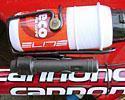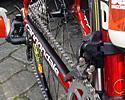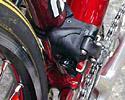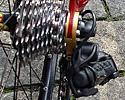
Recently on Cyclingnews.com |
Eye Spy: Campagnolo's 2nd generation Electric gruppo
By Paul Mirtschin and Tim Maloney
Got tech? Send press releases, news, and tech questions to the Cyclingnews tech-heads.
While the Cyclingnews staff were prowling around the team bus area at last weekend's 46th E3 PrijsVlaanderen in Harelbeke, Belgium, our eagle-eyed editor Jeff Jones noticed something different as he was admiring the SAECO Cannondale CAAD 7 team bikes.
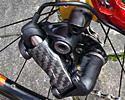 |
It seems that Saeco's Giosué Bonomi was testing Campagnolo's Electric group in its first-ever professional racing test and Jeff snapped some pictures of the second generation of Campagnolo Electric group.
Last year, Italian amateur Emmanuel Sella of the Zalf Fior team used a prototype version in both training and at the amateur Giro d'Italia, which led to the much-refined version we can see here. Campagnolo probably felt that the 209 km Belgian semi-classic, with its numerous cobbled climbs and changes of rhythm was an ideal testing ground for the second generation of Campagnolo Electric group, as it seems Bonomi had no problems with the Campagnolo Electric group at E3 PrijsVlaanderen.
Electronic shifting is not new; Mavic's ZAP system debuted in 1994, while their Mektronic system is still being sold. However, a lightweight, race-ready system that operates both the front and rear derailleurs have been a long time coming. Until now, that is.
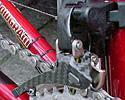 |
According to unofficial sources, the Campagnolo Electric group has been in development for several years. In fact, the idea is rumoured to have first been explored after Mavic released the ZAP system in 1994. Nevertheless, Campagnolo continued to develop their system until they felt it was getting close. The main hurdle that needed to be overcome was the front derailleur. Moving the rear was found to be relatively easy, but shifting the front needed a lot of force, and that in turn required larger batteries.
However, Campagnolo worked out a way around this using motors instead of solenoids, and have kept the whole unit down to a respectable race weight. By using a wired system instead of a wireless, we have been told that the system is as light and reliable as possible, as most of the wireless systems explored had problems with electronic interference.
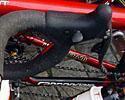 |
Most of the components are carbon fiber, and as a result is slightly lighter than a conventional Record group - despite the battery pack, which looks like a short hand pump next to the bidon cage. The gear and brake levers are very similar to the standard Record levers, albeit a little smaller. The reason is that it is ergonomic, and it works.
With the system entering its second stage of race testing, we can assume that the system is close to finished; all that will remain is fine-tuning of reliability and functioning, and the elongation of battery life. However, as much as we ask, Campagnolo will not give us a timeline to bring this innovative new product to market.
Photos
Images by Jeff Jones/Cyclingnews.com
- Looking up at the new electronic levers
- The new levers from the side
- The finish suggests the system won't be too far off
- From the top, the shift levers are more noticable
- The battery and holder
- Looking down on the front derailleur
- A close-up showing how small the housing is
- From the back you can see where the motor sits in the rear derailleur
- The rear deraileur looks very nice indeed
- From this angle you can see the large motor used for the front derailleur
- A closer look at the battery
- Carbon is used wherever possible to reduce weight
- A close-up of the front cage
- This is where most of the weight is
Recent techTour tech: Zipp's slippery
new wheel revealed |


